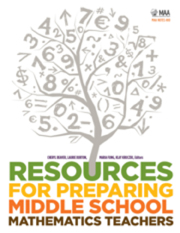Book contents
- Frontmatter
- Preface
- Contents
- I Programs for Middle School Teachers
- B In-service Training Programs
- 5 The Master of Arts in Middle School Mathematics Program at Salem (MA) State University
- 6 The Math in the Middle Institute: Strengthening Middle Level Teachers' Mathematical and Pedagogical Capacities
- 7 A Professional Development Program for Middle School Math Teachers in Maryland
- II Courses for Middle School Teachers
- B Geometry
- C Number Theory and Abstract Algebra
- D Precalculus and Calculus
- E Probability and Statistics
- F Combination Courses
7 - A Professional Development Program for Middle School Math Teachers in Maryland
from B - In-service Training Programs
- Frontmatter
- Preface
- Contents
- I Programs for Middle School Teachers
- B In-service Training Programs
- 5 The Master of Arts in Middle School Mathematics Program at Salem (MA) State University
- 6 The Math in the Middle Institute: Strengthening Middle Level Teachers' Mathematical and Pedagogical Capacities
- 7 A Professional Development Program for Middle School Math Teachers in Maryland
- II Courses for Middle School Teachers
- B Geometry
- C Number Theory and Abstract Algebra
- D Precalculus and Calculus
- E Probability and Statistics
- F Combination Courses
Summary
Introduction
Hood College is a small (1400 undergraduates, 1000 part-time graduate students), private liberal arts college in Western Maryland. To respond to the needs of the community, we designed a master's degree in mathematics education for current teachers of mathematics, with a special track for middle school teachers. The program is interdisciplinary. It was designed by a team of faculty from the Departments of Education and Mathematics at Hood, along with consultants from the local public school system. Our goal is to help middle school math teachers who hold a certificate in elementary education become highly qualified teachers (HQTs) under Maryland's interpretation of the No Child Left Behind provisions. There are currently twenty-five students enrolled in the middle school track of our program.
Background and History
Until recently, Maryland did not offer middle school certification in any subject. Although certification in middle school mathematics is now a possibility [1], most middle school mathematics teachers are certified either in Elementary Education, Grades 1–6 and Middle School or in Secondary Mathematics, Grades 7–12. To be considered a highly qualified middle school math teacher, new teachers (hired after January 8, 2002) must hold a bachelor's degree, hold a valid teaching certificate, and either pass the Praxis II test in middle school math or have completed a major (or equivalent) in mathematics. Experienced teachers (hired before January 8, 2002) need to meet these requirements or earn enough points in a complicated rubric, Maryland's “High, Objective, Uniform State Standard of Evaluation” [2]. As of 2007, approximately 26% of the mathematics courses taught in Maryland schools were taught by non-highly qualified teachers, as defined by the Maryland State Department of Education [3]. Thus, there is a need to help teachers become highly qualified.
- Type
- Chapter
- Information
- Publisher: Mathematical Association of AmericaPrint publication year: 2013

